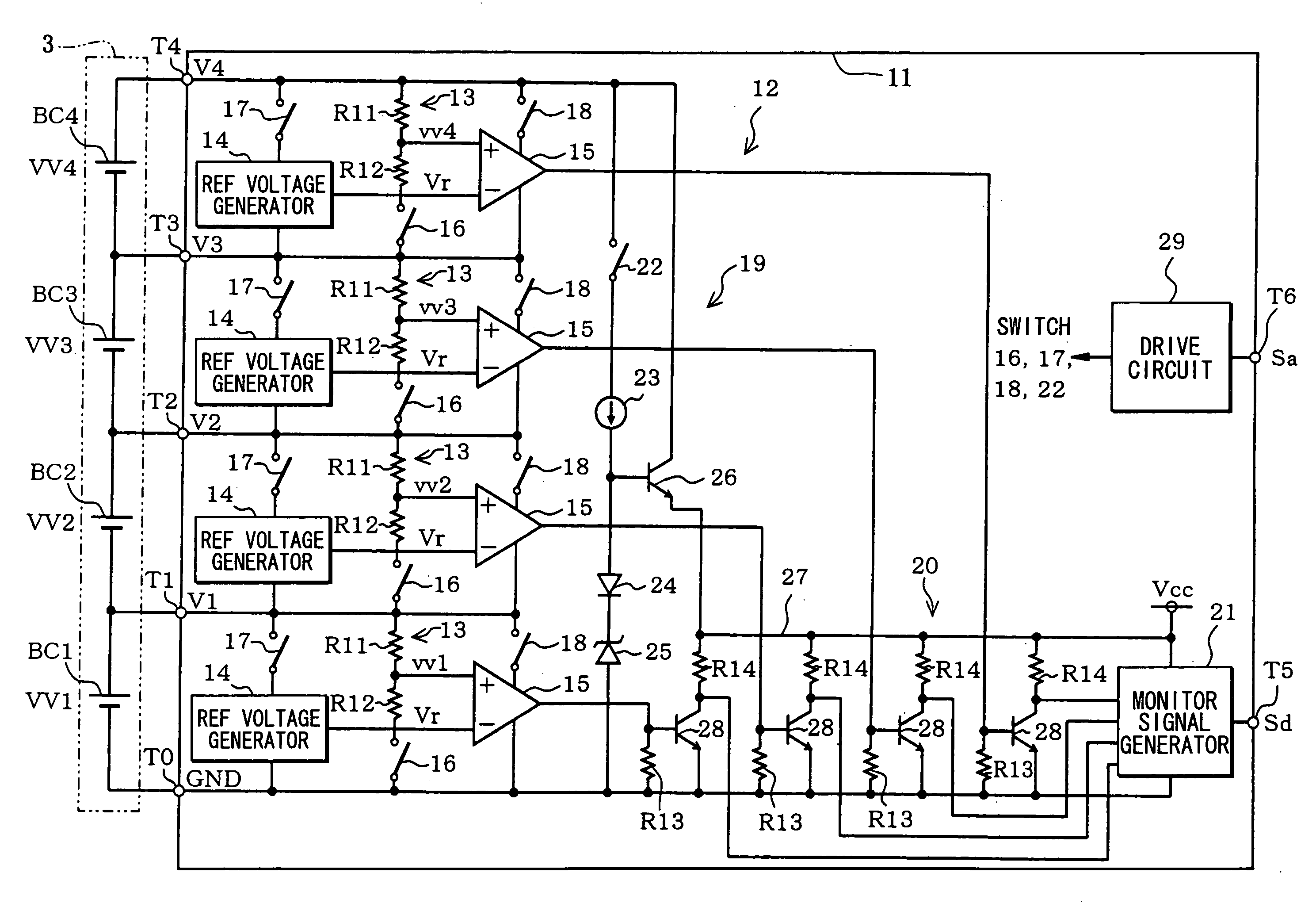Semiconductor integrated circuit device
a technology of integrated circuit and semiconductor, which is applied in the direction of instant pulse delivery arrangement, battery arrangement, pulse manipulation, etc., can solve the problems of large current consumption, large chip size of ic b>1/b>, and significant decrease in the capacity of secondary cells, so as to reduce current consumption and reduce chip size
- Summary
- Abstract
- Description
- Claims
- Application Information
AI Technical Summary
Benefits of technology
Problems solved by technology
Method used
Image
Examples
first embodiment
[0028]Referring to FIG. 1, an integrated circuit (IC) 11 according to a first embodiment of the present invention includes a cell voltage monitor circuit 12 that monitors cell voltages VV1-VV4 of secondary cells BC1-BC4 connected in series. The cells BC1-BC4 construct an assembled battery 3. For example, the assembled battery 3 is used as a battery for an electric vehicle (HEV) and a hybrid electric vehicle (HEV). The secondary cells BC1-BC4, may be for example, lithium ion cells. The IC 11 has input terminals T0-T4 and output terminals T5, T6. The cell BCi is connected between the input terminals T1-1, T1, where i is an integer from 1 to 4. For example, the cell BC2 is connected between the input terminals T1, T2.
[0029]When at least one of the cell voltages VV1-VV4 of the cells BC1-BC4 exceeds a predetermined reference voltage, a monitor signal Sd having a first level (e.g., high level) is outputted from the output terminal T5 of the IC 11. Further, when an interruption signal Sa (...
second embodiment
[0047]An IC 37 according to a second embodiment of the present invention is described with reference to FIG. 3. Differences between the IC 37 shown in FIG. 3 and the IC 11 shown in FIG. 1 are as follows:
[0048]A comparator 15 provided to a cell BC1 is powered by a voltage supplied via a switch 18 from between positive and negative terminals of the cell BC1. The cell BC1 is arranged on the lowest potential side of the assembled battery 3. The comparator 15 provided to the cell BCi is powered by a voltage supplied via a switch 18 from between a positive terminal of a cell BCi and a negative terminal of a cell BCi-1, where i is an integer from 2 to 4. For example, the comparator 15 provided to the cell BC3 is powered by a voltage supplied via a switch 18 from between a positive terminal of the cell BC3 and a negative terminal of the cell BC2.
[0049]In such an approach, even when the cell voltages VV1-VV4 decrease significantly, the comparison circuit 15 provided to each of the cells CB2-...
third embodiment
[0052]An IC 11a according to a third embodiment of the present invention is described with reference to FIG. 4. Differences between the IC 11a shown in FIG. 4 and the IC 11 shown in FIG. 1 are as follows:
[0053]In the first embodiment, as shown in FIG. 2, each element is electrically isolated by the trench 34 formed on the single crystal silicon layer 32 of the SOI substrate 33.
[0054]Like in the first embodiment, in the third embodiment, each element is electrically isolated by the trench 34 formed on the single crystal silicon layer 32 of the SOI substrate 33. Further, each circuit forming region, where elements operating with respect to the same potential are formed, is electrically isolated by an additional trench. Specifically, as shown in FIG. 4, circuit forming regions, where the sub monitor circuits are formed, respectively, are isolated from each other by the additional trench. Further, a circuit forming region, where the power supply circuit 19, the C / V conversion circuit 20...
PUM
 Login to View More
Login to View More Abstract
Description
Claims
Application Information
 Login to View More
Login to View More - R&D
- Intellectual Property
- Life Sciences
- Materials
- Tech Scout
- Unparalleled Data Quality
- Higher Quality Content
- 60% Fewer Hallucinations
Browse by: Latest US Patents, China's latest patents, Technical Efficacy Thesaurus, Application Domain, Technology Topic, Popular Technical Reports.
© 2025 PatSnap. All rights reserved.Legal|Privacy policy|Modern Slavery Act Transparency Statement|Sitemap|About US| Contact US: help@patsnap.com



